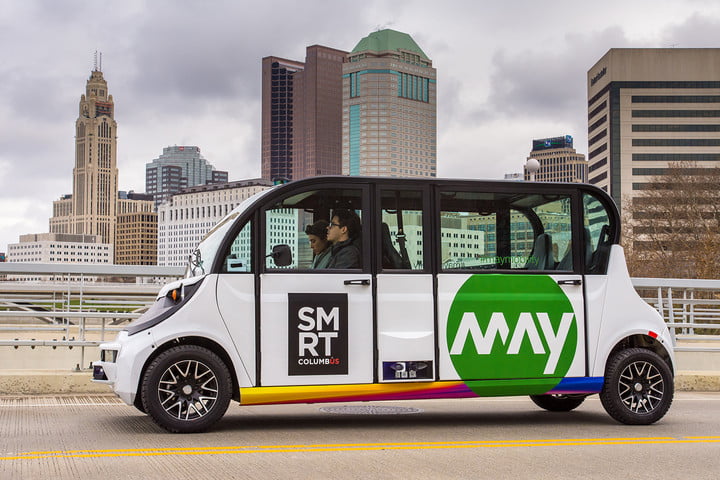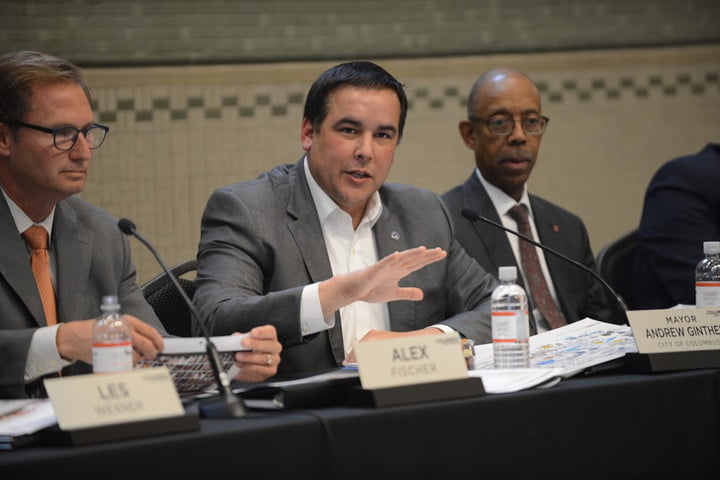Columbus Mayor Talks Progress in Smart City Goals

It was just over two years ago that Columbus, Ohio, won the Department of Transportation’s $40 million Smart City Challenge, beating 77 other U.S. contenders. It was a major shot in the arm for a city of about 900,000 people. The municipality has since been wending through projects, part of what’s dubbed Smart Columbus, and will start its first autonomous shuttle rides for the public beginning on December 10. But not all the milestones in its various smart city initiatives have had that much sex appeal.
“Try talking to people about integrated data exchange and their eyes glaze over,” Andrew Ginther, mayor of Columbus, told Digital Trends.
Much of the work needed to enable smart services requires mundane kinds of changes in the back office that the public doesn’t see. One key component, for example, has been the Smart Columbus Operating System (SCOS). A decade ago, all-in-one virtual dashboards integrating vital city data — traffic conditions, fire and police reports, electrical grid status, public transportation systems — were touted by tech companies, but none of the systems ever gained significant traction. SCOS is an attempt to remedy that by building a platform to aggregate, assimilate, and coordinate municipal data.
Launched last spring, the SCOS rakes in 1,100 data feeds in an effort to solve mobility-related issues. The datasets, which the city plans to make accessible to companies for creating solutions, include such things as information about food banks to help the disadvantaged get the groceries they need. Other data sets include the precise location of low bridges in the area to prevent trucks from striking them and causing property damage and traffic problems. There’s also important demographic information, such as where most older adults reside, that can help city planners better deploy transportation systems to serve their needs.

“Mobility is the great equalizer of the 21st-century,” Ginther said.
Without the necessary access to transportation, people can’t get access to jobs, education, and proper healthcare, he explained. There’s also recognition that some areas are underserved — such as so-called food deserts — and providing transportation to those areas can significantly improve the lives of its citizens.
Read more about Columbus’ smart city ambitions.
Where’s the utopian city?
“After we won the smart city grant, people said, ‘So when are you going to build it?’,” Ginther said, explaining that the initiative involves innumerable small steps.
There’s now an app, for example, that can tell people where their local bus is — a definite bonus in a place like Columbus where you may have to stand outside in bone-chilling weather waiting for a ride. Another example of how such information can be used is a new website that alerts drivers when there’s a train blocking the railroad crossing at the intersection of SR 11 and State Road 46. It will allow the estimated 60,000 drivers a day who get stuck there to take an alternate route.

Columbus is making access to this information free to public and private organizations, to encourage the development of even smarter solutions. And the city hopes that other towns and cities will employ the SCOS platform to build their own tailored solutions for making communities more intelligent and efficient.
It’s all part of taking a long view to smart city solutions, Ginther said. There are about 2.5 million people currently living in the Columbus region, for example, but the population is expected to swell to over 3 million in the next few years, he said. That growth is fueled by the attraction of a burgeoning tech scene and numerous educational institutions ranging from Ohio State University, with nearly 60,000 students, to smaller but highly regarded colleges like Kenyon. However, there’s no subway or light rail system in the area.
“So the 80-percent single occupancy vehicle is not sustainable,” Ginther said, referring to the fact that most people in his city now drive alone.
Consequently, Columbus is considering different transportation solutions. Toward that end, Smart Columbus has just launched its much-anticipated Smart Circuit self-driving shuttle. Riders can use the shuttle for free on a 1.5-mile route. The fully electric autonomous vehicle will only travel at a maximum speed of 25 miles per hour and carry just a handful of riders, but it’s seen as way to get people more comfortable with the technology.
The Smart Circuit will cover the city’s Scioto Mile, a popular destination with visitors and locals alike. The shuttle will run seven days a week, from 6 a.m. to 10 p.m. every day and make stops at the city’s Center of Science and Industry, the National Veterans Memorial and Museum, Bicentennial Park, and the Smart Columbus Experience Center. A 49-inch screen in the vehicle will offer system and route information to riders, and a human monitor will also be onboard in case of emergency. The shuttle itself is operated and maintained by a Michigan-based startup, May Mobility.
[From San Francisco to Singapore, find out more about smart cities around the world.]
The best place to test?
Ginther noted that Columbus has traditionally been known as “Test City, U.S.A.,” where companies test market everything from cayenne ice cream to malt balls. He thinks the same could hold for autonomous vehicles because of Columbus’ variety of traffic and weather condition — versus a Phoenix or Austin, where snow is rarely a factor.
Certainly, the state of Ohio is also working with and encouraging efforts in Columbus. DriveOhio, for example, is an Ohio Department of Transportation division that is working with the city on the Smart Circuit effort. The DOT already has launched projects to create a smarter infrastructure, such as smart road programs covering 164 miles of streets and highways.
And the state continues to encourage future transportation alternatives. In the area of unmanned aircraft systems, otherwise known as drones, the state is launching FlyOhio projects that include using ground-based detect-and-avoid radar so that drones could be used in traffic management. The state will also be using drones on a 35-mile smart mobility highway between Dublin and East Liberty in Ohio, where autonomous and vehicle-to-infrastructure communications tests are already underway.
It’s all part of anticipating the future and planning for coming changes, many of which will result from the transformation of transportation.
In addition to reaching the under-served, Ginther says another major focus of Smart Columbus is how to address the need for affordable housing. He admits the city isn’t yet facing the real-estate challenges that cities like Denver and San Francisco have already encountered, but he says the city needs to think about new solutions as transportation needs change from, say, single car ownership to shared mobility services.
“So, how can we build a parking garage so that it can be repurposed and reused in the future?” Ginter asked.
It’s by answering questions like that Columbus hopes to become a truly smarter city.




